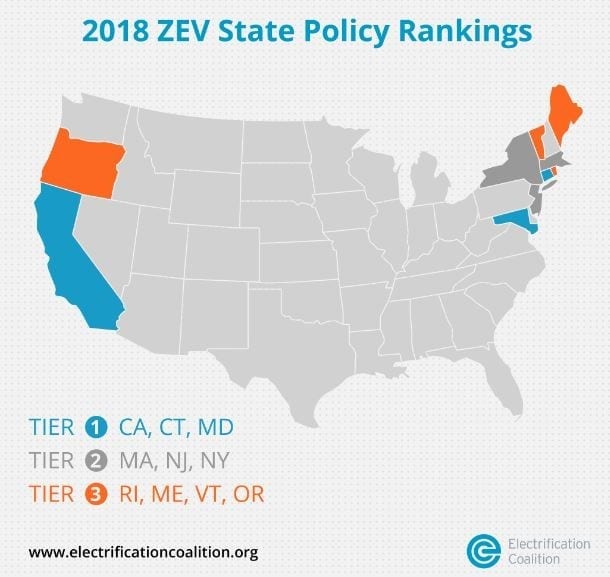Electric vehicle (EV) sales have steadily risen in the United States this decade, and are forecast to continue to penetrate the car fleet in coming years and decades, with possible widespread implications for petroleum use. Who is leading the way and what can policymakers, companies, and consumers continue to do to sustain this upward trend? To help stakeholders guide policy and investments in the future, the Electrification Coalition (EC) released its first Zero Emissions Vehicles (ZEV) Scorecard on Thursday, analyzing the effects of strategies used by states to encourage EV adoption in states participating the ZEV Program.
Electric vehicle (EV) sales have steadily risen in the United States this decade, and are forecast to continue to penetrate the car fleet in coming years and decades.
“Government policy to catalyze a self-sustaining market for EVs is crucial,” the report says.
California’s ZEV Program is a prime example of government taking initiative to foster the adoption of EVs. Nine other states are also requiring automakers to acquire ZEV credits by producing and delivering EVs for sale. Governor Brown of California recently set a target of 5 million ZEVs in California by 2030. In order for this policy to succeed, the state needs coordination, flexibility, and investment from the auto industry, state and local governments, energy utilities, consumers, and others.
“While there are more than 700,000 EVs on U.S. roads today, electric vehicle are still only about one percent of U.S. light-duty vehicle sales. As state legislatures look to automakers to increase the availability and diversity of PEV models in all ZEV MOU states, the scorecard is meant to be used as a resource for the public and policymakers,” said Ben Prochazka, Vice President of the Electrification Coalition.
The purpose of the ZEV State Policy Rankings is to comprehensively assess states’ actions and how they can help build a sustaining EV market by tracking policy changes that spur EV adoption.
ZEV Scorecard’s methodology
The purpose of the ZEV State Policy Rankings is to comprehensively assess states’ actions and how they can help build a sustaining EV market. The rankings track policy changes over time and inform lawmakers of actions that effectively spur EV adoption. To determine the rankings, we included three weighted metrics: state-provided incentives to consumers; availability and support of public refueling infrastructure; and outreach campaigns to educate the public. Altogether, the Scorecard uses 14 metrics across the three categories, and every state is awarded a 0-3 score for each one. The model applies weightings for each metric based on its relative importance to ZEV adoption. The scorecard ranks each state, and then sorts them into three tiers.
The growth in EVs and expectations they will become a larger part of the U.S. fleet matters because the transportation system relies almost exclusively on petroleum-based fuels, exposing consumers and business to economic and national security risks.
ZEV Scorecard’s findings
As expected, California ranks first in the inaugural ZEV State Policy Rankings. Adoption by consumers and businesses is in large part the result of the state’s large network of existing and planned refueling infrastructure, robust enticements for vehicle purchases, and continuous outreach programs. Maryland and Connecticut are also in the top tier (see below), while all ten states are ahead of the rest of the country in EV development. Nonetheless, in coordination with other stakeholders, states can further establish and enhance policies that will more effectively support the development of the EV market and facilitate widespread EV adoption. These policies include:
- Ensuring that financial and non-financial incentives remain properly aligned with program goals.
- Developing infrastructure through facilitating coordination among multiple stakeholders.
- Public awareness campaigns will also be critical: State governments should lead by example by offering workplace charging at state facilities, incorporating more EVs into their fleets, and promoting the use of alternative fuels.
The United States and oil dependency
The growth in EVs and expectations that they will become a larger part of the U.S. fleet matters because the country’s transportation system relies almost exclusively on petroleum-based fuels, exposing consumers and business to economic and national security risks. As noted above, EVs now make up only 1.5 percent of total sales. Almost 40 percent of total U.S. primary energy demand is met by oil, and the transportation sector accounts for more than 70 percent of the approximately 20 million barrels per day (Mbd) consumed.
Widespread adoption of PEVs will mitigate price risks to consumers, businesses, and the broader economy by providing fuel diversity and insulating motorists from global oil price volatility and strengthening energy security.
Moving away from petroleum will be a long-term undertaking, given that the 250 million registered light-duty vehicles in the U.S. account for more than 60 percent of oil consumption, reinforcing the need for alternative fuels such as electricity. “Although the United States has faced serious challenges over the past several decades as a result of its oil dependence, these would have been more severe without the progress made to improve the fuel efficiency of light-duty vehicles,” the report says.
Electric vehicles as a solution
EVs have a number of benefits compared to internal combustion engine (ICE) vehicles. Fuel costs for EV owners are considerably less expensive and energy intensive than operating one on gasoline or diesel. “Electricity prices are substantially less volatile than gasoline or diesel prices, increasing by an average of less than 3 percent per year in nominal terms since 2000,” says the EC in the report.
Widespread adoption of PEVs will mitigate price risks to consumers, businesses, and the broader economy by providing fuel diversity and insulating motorists from global oil price volatility and strengthening energy security. Furthermore, miles traveled with PEVs emit less carbon dioxide than ICE vehicles. This is true even with today’s mix of electricity-generating resources—which will only get cleaner as more renewables are integrated into the grid.



